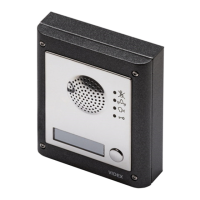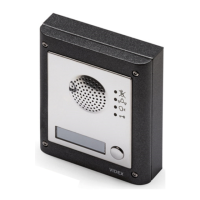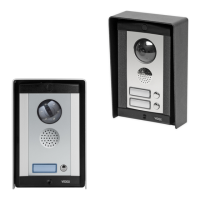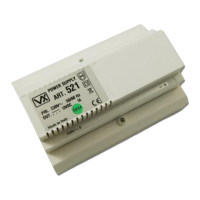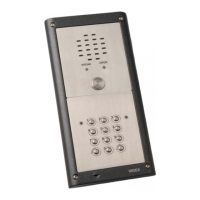66250754-4G-EN - V2.0 - 28/03/22
- 48 -
4000 Series GSM Audio Intercom - Technical Manual
4000 Series GSM Audio Intercom with Proximity
Programming the GSM Intercom
1111ATBn”HHMMHHMM”,days Store the time period for timeband n, where n = timeband no. (0 - 9) using this format:
the rst HHMM is the start time for fobs/cards and access codes to be active (i.e. 0845
for 8:45am in the morning) and the second HHMM is the end time when fobs/cards and
access codes will stop being active (i.e. 1930 for 7:30pm at night) and where days = Mo, Tu,
We, Th, Fri, Sa, Su, AD, WD, WE.
1111ATBn”HHMMHHMM”,days? As above but also send a conrmation text back to the sender with the stored setting.
1111ATBn? Query timeband n setting, where n = timeband no. (0 - 9) A text message will be sent to
the sender with the stored timeband no., time period and days active for.
1111ATBn”” Delete timeband n, where n = timeband no. (0 - 9).
1111ATBn””? Delete and conrm deletion of the timeband.
Example 1: To set timeband 0 to allow for proximity fobs/cards, access codes and dial to open numbers to be active between
8:00am in the morning up until 2:00pm in the afternoon and for weekends only, the following text can be sent to the
GSM intercom, remembering to use 24hr clock notation:
1111ATB0”08001400”,WE?
The GSM intercom will reply with the following text:
ATB0 = 08001400,Su,Sa
VIDEX 4G
Example 2: To set timeband 1 to allow for proximity fobs/cards, access codes and dial to open numbers to be active between
2:00pm in the afternoon until 3:00pm in the afternoon and for Mondays, Wednesdays and Fridays only, the following
text can be sent to the GSM intercom, remembering to use 24hr clock notation:
1111ATB1”14001500”,Mo,We,Fr?
Note that commas , are used where appropriate to separate the days required for the timeband. The GSM intercom
will reply with the following text:
ATB1 = 14001500,Mo,We,Fr
VIDEX 4G
Note that in both examples shown the conrmation text message from the GSM will include the day or days of the
week shown after the timeband period.
IMPORTANT NOTE: When using the Art.4903 keypad the ATB timebands feature only applies to the additional 400 (000 - 399)
access codes and 32 (400 - 431) temporary codes. Any codes programmed for relays 1 and 2 directly via the keypad will work as
normal and are not aected by the timebands. It should also be noted that the ATB timebands feature cannot be used alone it
must also be used in conjunction with the access levels feature ACC described on the following page.
STORE ACCESS LEVELS FOR ACCESS CONTROL: PROXIMITY & ACCESS CODES TO BE ACTIVE FOR ACC
The access levels feature (ACC) allows the 10 access control
timebands (ATB ) to be assigned to one of or a combination of up
to 10 access levels (0 - 9). Each of the access levels can also have
proximity readers (Art.4850R), including the GSM’s onboard
reader, or keypads (Art.4903) or a combination of both assigned
to them aswell by using the readers/keypads unit ID (1 - 8). In
short access levels are made up of both timebands and reader
groups where reader groups are made up of a combination of
proximity readers and keypads, see Fig.80.
This feature of the GSM intercom is particularly useful on systems
where restricted access is required where users may only be
allowed access through dierent readers/keypads and at dierent
times of the day.
Before setting up an access level it is recommended that any
timebands that may be required are setup rst following the
access control timebands programming command ATB described
on the previous page.
Use the following text messages shown in the table below to
store, query and delete an access level.
Time Period/Days
00:00 - 23:59
Mo, Tu, We, Th,
Fr, Sa, Su, AD,
WD, WE
Art.4850R/Art.4903
Combination of
up to 8 readers
and/or keypads
(inc. GSM PRO’s
onboard reader)
TIMEBANDS
(0 - 9)
READER
GROUP(S)
ACCESS LEVELS (0 - 9)
Fig. 80
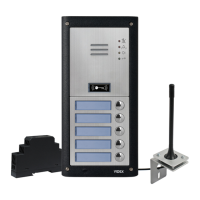
